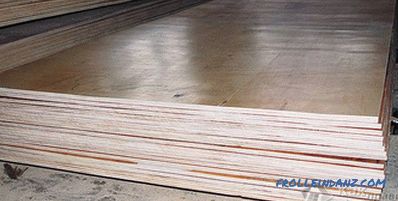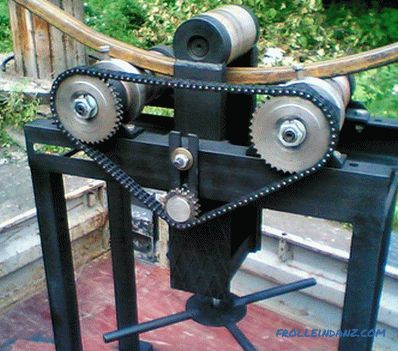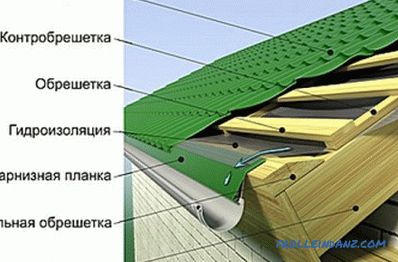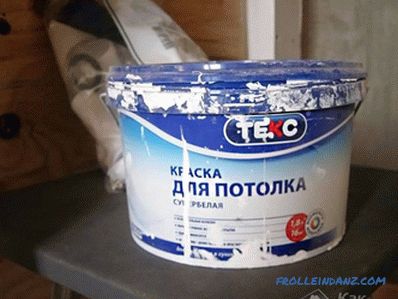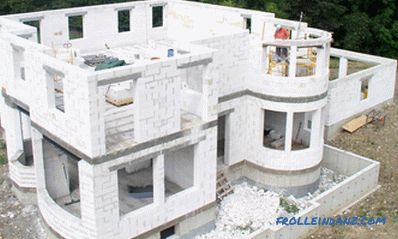Interior doors are an important part of the interior. From their choice depends not only practicality and functionality, but also comfort and aesthetics at home. To understand how to choose interior doors correctly, from all possible options, you need to read this article - here you can find all the necessary information regarding the device, types, functionality and price.
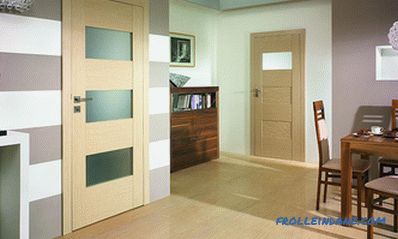
Device of main types of interior doors
You can choose interior doors from four design options, which are manufactured industrially and are distinguished by the greatest practicality and usability. It should be noted that all the options are almost identical in convenience, but, nevertheless, each design has its own characteristics. produce the following types of doors panel, paneled, molded, tsargovye. What are their differences?
Flush interior doors
Sometimes this door design is called a frame, which also very accurately reflects the features of the device. The basis of the door - a solid frame made of solid wood. The most commonly used pine, as the most simple to process and inexpensive material. On both sides, the frame is sheathed with MDF sheets, and the voids inside, between the frame elements, are filled with light insulating material or a cellular construction made of cardboard or MDF.
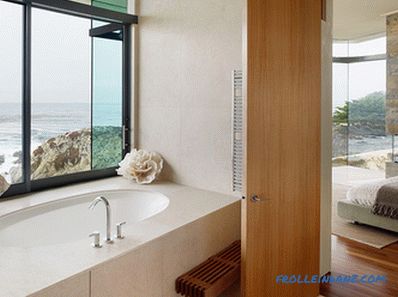
The doors on the outer planes are decorated with natural veneer, laminate, PVC film or other finishing materials. In accordance with the design in the canvas can be cut a hole of any configuration for the glazing. In the places of installation of glass and mounting of baguette, the frame of the door is strengthened, as well as in the area of installation of the door handle.
Panel door device :

1 . Cellular filler.
2 . The frame of pine bars.
3 . Gain to install the lock.
4 . MDF canvas.
5 . Laminated or PVC coating.
The advantages of frame doors:
- low weight;
- low price;
- many trim options;
- structural strength.
Paneled doors
Their design is also based on a wooden frame made of solid wood and bars. In addition to external strapping in the frame, there are internal elements in the form of vertical posts and horizontal bridges. The space between the parts of the frame is filled with special shaped elements - panels, which are type-setting or massive plates, in the form of the corresponding configuration of openings. Part of the area of the canvas can be filled with glass or other decorative material.
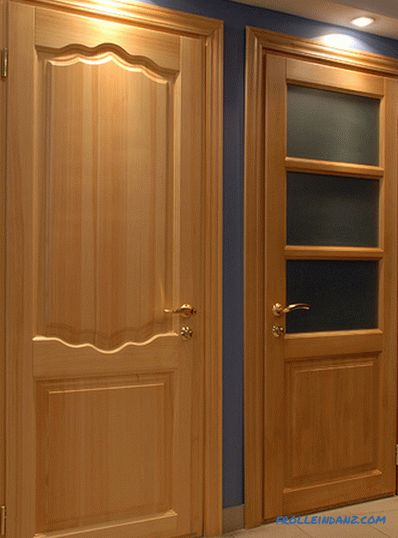
Panels are made of pine, fine wood or are combined with MDF. It provides a wide range of door design options without loss of durability and quality. The design is somewhat heavier and more expensive than the shield, but stronger and more resistant to frontal and lateral deformations.
Panel door :
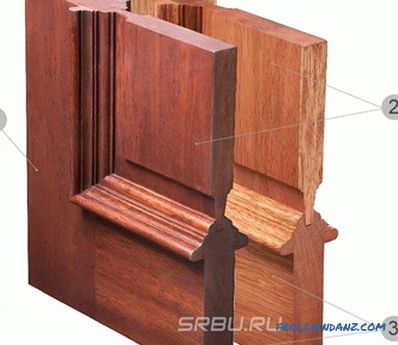
1 . Vertical bar trim.
2 . Fillets.
3 . Cross beam.
Benefits:
- durability;
- exquisite appearance;
- multivariate finish;
- sufficient sound insulation.
Side doors
Such a door is assembled on a wooden frame by filling the openings with horizontal planks (bars) - side bars. The design is quite massive, which is fully compensated by its strength. In addition, tsargovye elements can be combined with glass or other materials, which allows you to create an unlimited number of design options.
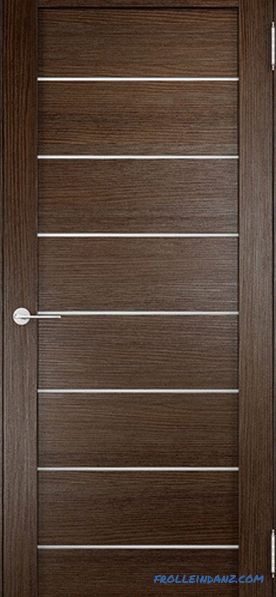

In appearance, these doors look like a composite construction of individual elements, however, cause a feeling of strength and reliability, which is in fact - the king’s doors are as strong as paneled doors, but a little heavier.
Structure of sill doors :
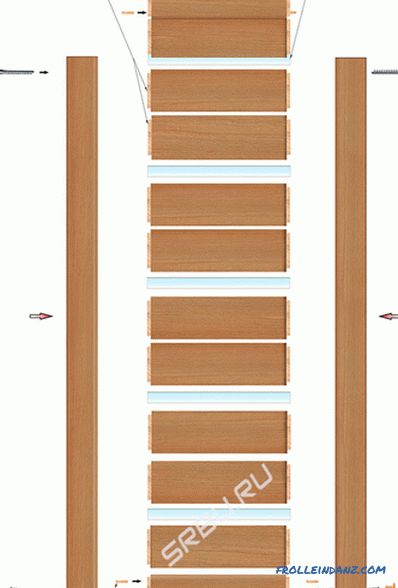
1 . The elements of the canvas.
2 . Tsarga
3 . Glass insert.
4 . Decorative cap.
5 . Coupling screw.
6 . Stand profile.
7 . Shkant
Benefits:
- strength;
- durability;
- resistance to deformation;
- great design.
Molded doors
Their design is as simple as possible - a frame made of laths or metal around the perimeter and an internal filling of glass. There are options with filling with an opaque panel, also in full height and design with an additional central rack.
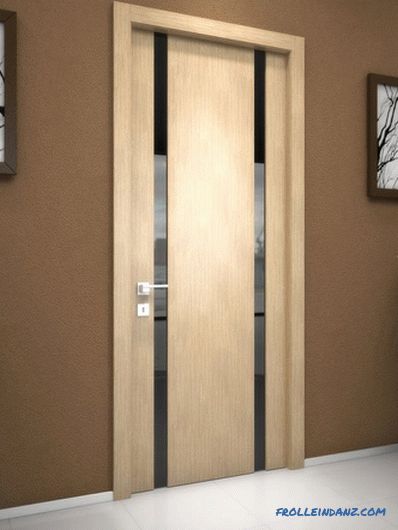
Glass for doors is used unbreakable, but its large size determines the considerable weight of the door assembly. In addition to glass for decoration, wooden, plastic or metal elements can be used that adorn the structure, but also make it heavier.But despite this, the door’s weight is far from being critical, and the original appearance allows them to be used in any interior style, but they look best in modern apartments and houses (techno, high-tech, eclectic).
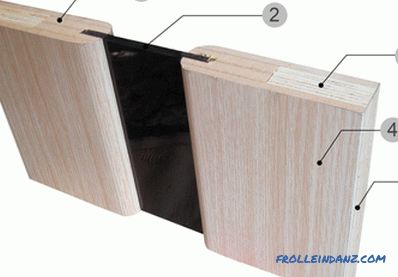
1 . MDF.
2 . Glass triplex.
3 . Bar from the massif of wood.
4 . PVC film.
5 . PVC edge.
Benefits:
- durability;
- excellent design;
- unlimited in size.
To understand how to choose interior doors in terms of quality, it is necessary to understand that in design and number of design options - almost all designs are equivalent. The price of panel doors is the most affordable, framed - the highest. The strongest will be paneled and tsargovye doors from the array.
Production material and door finishing method
An important characteristic when choosing an interior door is the type of material from which it is made. A variety of designs determines the possibility of manufacturing doors from a variety of natural and artificial materials - wood, metal, glass, MDF, chipboard and others.
Doors from solid wood
If you focus only on strength, then nothing is better than solid wood - it is an expensive, but very reliable and high-quality material. Most often these doors have a framed construction. These doors fully comply with another important requirement for the interior design - sound insulation. But at the same time operation of doors from the array causes some difficulties. They are:
- are sensitive to changes in humidity;
- are quite heavy, which requires installation of additional loops;
- are prone to drying out.
In the manufacture of solid wood doors, careful selection of specially dried material is required, as well as a considerable amount of time for its processing and finishing.
Oak, beech, and nut are the most commonly used types of wood, but they are only suitable for expensive doors made to order. Like mahogany, these are handmade breeds and it is almost impossible to buy quality doors from valuable wood in stores. But you can find good doors made of pine or spruce, at least - larches. When using quality stains and varnishes, they can be turned into real works of art, indistinguishable from the work of cabinetmakers.
Especially since pine and other conifers are not as susceptible to cracking and cracking as oak or beech. In addition, the price of finished interior doors of conifers is much lower, and soundproof and decorative qualities are almost on the same level, especially if glazing is used.
But in the construction of panel door, panel (under the trim) and molded doors, the pine acts as the main material - the frames are extremely durable, not subject to deformations and even without antiseptic treatment have a very high level of resistance to biological lesions - mold, flowering and rot. The coniferous wood contains enough resin of its own, so that the service life is not inferior to the treated wood in a dry atmosphere. Doors for bathrooms, baths and saunas require more complex preparation.
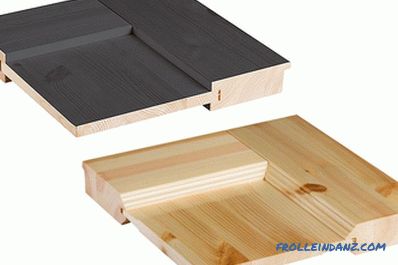
In most cases, doors made of solid wood will outperform constructions made of synthetic materials, but lose to them in such an important parameter as price.
Doors made of artificial materials
The use of such materials makes interior doors cheaper without losing basic consumer properties. To begin with, let's sort out what internal filling can have doors made of artificial materials. In fact, the variety of internal content is great. As such materials can be used: pine bars, chipboard, MDF, cellular cardboard. At the same time, chipboard and MDF boards can be both solid and cellular. Hollow plates affect the strength of the door, but makes them easier and cheaper.
It is best to buy doors made of MDF - wood fiber boards based on natural resins. It is a durable, water-resistant, environmentally safe material that is easily processed and allows you to get quite complex in configuration.
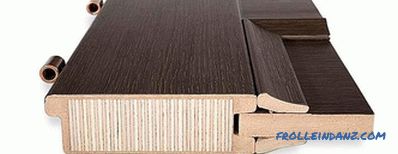
Doors with MDF filling.
MDF plates are more preferable than chipboard, especially as part of interior design. For the production of chipboard used synthetic binders that are prone to release not very safe fumes when heated. Structures made of chipboard are somewhat heavier, which requires reinforcement of the frame and loops.
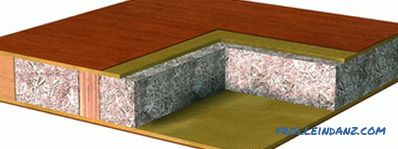
Doors of monolithic chipboard.
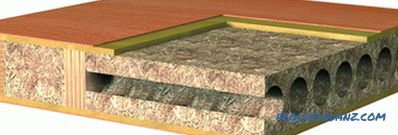
Doors made of hollow chipboard.
Often, low-value wood is used as an internal filling, which is a good solution. However, the cost of such doors is somewhat higher.
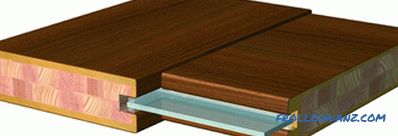
Doors filled with wood bars.
If the budget allows, then the purchase of doors with a filler of cellular cardboard should be abandoned. These doors have the lowest strength. If their outer coating has a small thickness, then it is very easy to punch them by accidentally hooking them with an object.

Doors filled with aerated cardboard.
Regardless of the internal filler along the contour of the frame, pine or spruce bars always apply rigidity to the structure.
But the most important role is played by the external coating, which is not only in contact with the micro-atmosphere of the room, but is also capable of actively influencing it. But the influence of the atmosphere on a particular product should not be overlooked - humidity, temperature and dust levels greatly affect both the appearance and the life of the doors.
Laminate . One of the most common materials used for exterior doors, however, its popularity is determined not only by protective and decorative properties, but also by price. This is one of the cheapest coatings, but the definition of "cheap" does not mean poor quality. Laminate in 95% of cases fully justifies its purpose and perfectly protects the base, while possessing an excellent decorative appearance.
By technical nature, this is a special coating that is applied to a clean material or paper base with an imitation of the coloring of precious woods. Before you choose a laminated interior door, you need to find out how it reacts to high humidity, temperature fluctuations or an aggressive atmosphere, which can be, for example, in the kitchen or in the corridor leading to the bathroom. Aggressive can be considered an atmosphere quite safe for humans, but saturated with vapors of detergents or greasy fumes.
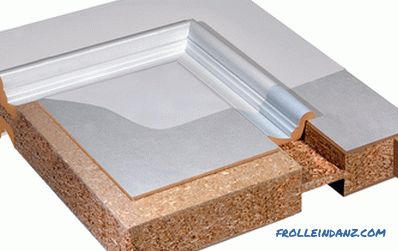
Chipboard doors covered with laminated MDF panels.
PVC coating . More comfortable in all respects doors covered with PVC film. It is shock-resistant material, characterized by high chemical and mechanical resistance. For design properties, it is not inferior to laminate. PVC coating is produced in a variety of colors, both standard, for various color fans and catalogs of LKM manufacturers, and in imitations of precious woods. Also on the film you can apply any photo printing, which is very important in non-standard interiors. In favor of their PVC coatings can be attributed to the exceptional color stability.
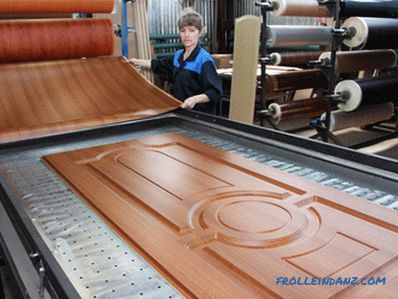
Natural veneer . As a cover for the base of interior doors, natural materials are often used - mainly veneer. It is a thin section of wood, with a thickness of 0.1 to 10 mm. The finest types of veneer are used to finish the doors, it is assumed that interior doors are not subject to high mechanical loads, do not interact with direct ultraviolet light and are not affected by sudden temperature changes.
Natural veneer, even the thinnest, perfectly conveys the characteristic texture of a certain kind of wood, perfectly retains its color and does not collapse under moderate physical effects. The veneer perfectly absorbs stains, paints and varnishes, has a high adhesion to adhesives, with the help of which it is fixed on the base. Often veneered doors are difficult to distinguish from products made of solid wood.

Doors made of chipboard and MDF covered with natural veneer.
Eco Hairline . A cheaper option is an eco skier. These are fibers of natural wood, bonded with synthetic resins. He completely repeats the pattern of natural wood, but is less ecologically sustainable. Often, formaldehyde and its components are used as a binder, which, even under a layer of varnish, is not entirely safe. At country houses, in country houses and rooms where people are relatively rare - this is one of the most convenient options, both in price and quality.
Vapor release of synthetic resins can begin only in exceptional cases, at a temperature in the house above +40 0 C or direct long-term exposure to sunlight. In other circumstances, eco-shears are no more dangerous than natural ones. The very name of this material suggests that this is an environmentally friendly material, in fact it is not. This material has nothing to do with natural veneer, except for appearance.
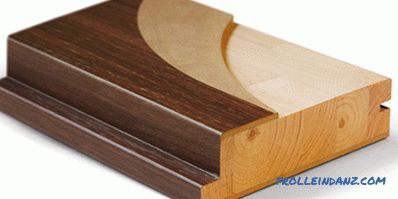
The doors of pine bars are trimmed with MDF panels and covered with ekoshpon.
Glass . To fill the openings of interior door frames, glass is one of the best materials. In addition to high design possibilities, the door glass with a layer of transparent plastic (triplex) is absolutely safe. Even with strong shocks, it is difficult to break it; when resolved, it does not form fragments or any dangerous parts.
Glass:
- tinted in any color;
- decorated with metal and wood;
- painted;
- turn into a mirror;
- stained.
The only drawback of glass is the low level of sound insulation, but in most cases it is not a decisive property.
Having summed up a little, we can say that the best solution would be doors made of MDF (preferably) or chipboard finished with natural veneer. But it will be the most expensive option. The next option is doors made of MDF or chipboard, finished with laminated flooring or eco pallets. The most budgetary variant is the PVC film finish, while at the same time it surpasses all coatings in design diversity.
Ways of opening the door
In addition to the material of manufacture and cost, in order to determine which interior doors should be chosen for the apartment, it is necessary to take into account their real functionality. One of the main properties is the way of opening. Most often door designs belong to one of four types:
- hinged;
- folding;
- sliding;
- swinging.
Depending on the layout of the house, the size of individual rooms and financial possibilities, doors are also chosen. Like most designs, only the most practical remained on the market. If, for example, sliding doors do not suit you, this does not mean that they are bad. Each of the types has its specific advantages, which manifest themselves only in specific circumstances.
Swing doors
Classic swing doors can be found in 90% of apartments and houses. Interior rarely double-wing, except when moving from a spacious hallway to the living room or dining room. In other cases, set single.
Installation of hinges and locks is not difficult on panel doors, nor on paneled or regal doors. The simplicity of the design does not reduce its functional properties - on the doors you can install both regular and extra-strong hinges, locks with a key, locks, latches. As a rule, hinged doors are installed on strong boxes, securely fastened in the walls.
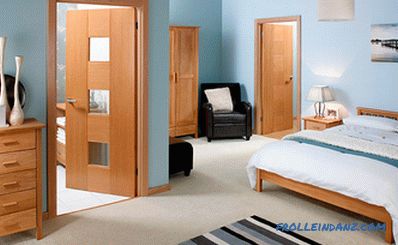
Sliding doors
The choice of this type of door is determined, in most cases, by the lack of space. To open them, no “dead zone” behind the doors is required - they simply move along the wall and hide in decorative structures or openly. Sliding doors can be made in all versions - the presence of upper and lower guides, along which the web moves, provides both structural stability and ease of operation.
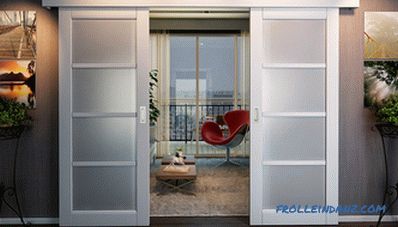
Folding doors
Interior doors are slightly more complex than sliding doors. The difficulty here is represented by the hinges on which the valves are fixed. The doors are assembled in the form of an accordion, which folds into a compact design. In terms of functionality, folding doors are in an intermediate position between swing and sliding doors, but they are significantly ahead of them in complexity of manufacture and operation.
Difficulties manifest themselves in the presence of numerous hinges, which, although operating at minimum loads, may be the weakest link. They can be carried out both in the form of a single sliding structure, and in the form of two canvases. The second option is more preferable - it assumes only two or three hinges, the load on which is very gentle. With a small weight of the valves, this design will serve no less than monolithic hinged or sliding doors.
But if there are more than two hinges, the number of nodes of increased risk increases, the doors become difficult to manage and relatively short-lived in operation. It is advisable to install folding doors in the form of fast-moving partitions, for example, when the living room needs to be quickly turned into a spacious dining room for family celebrations. By the level of decorative folding doors surpass all other types.

Swing doors
The least practical construction in terms of an apartment or a cottage. It is appropriate in public places. Difficult to install, adjust and operate. It is much better for design considerations, ease of use and monetary costs to install one or two swing doors.
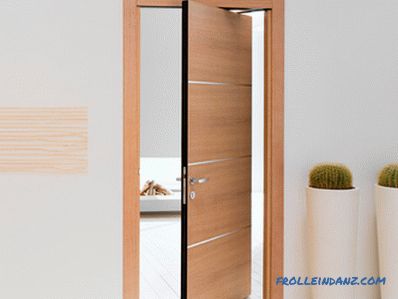
How to choose the size of an interior door
When choosing an interior door, the main role is played by functionality. You use the door several times a day, the slightest inconvenience immediately becomes noticeable and, if it is unavoidable, begins to irritate. Many tips on the choice of interior doors relate solely to the cost and material of manufacture, but completely forget about such characteristics as convenience.
This parameter largely depends on the size of the door leaf. The more it is - the more inconvenient to use.Practice has established the optimal dimensions of the canvas - 2000 x 600 x 700-800 mm. Given the size of the box, the opening under the door must be done somewhat more. No more than 1 cm thickness of foam or other sealant is allowed for sealing the joint.
Different sizes of doors are calculated for different rooms, the standard provides for:
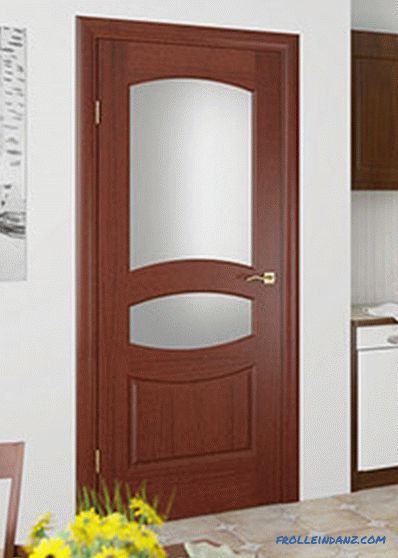
Kitchen
-
700 x 2000 x 70 mm.
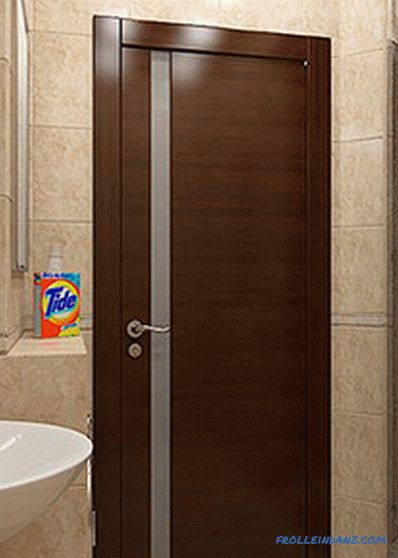
Bathroom
-
550-600 x 1900-2000 x 50 -70 mm;
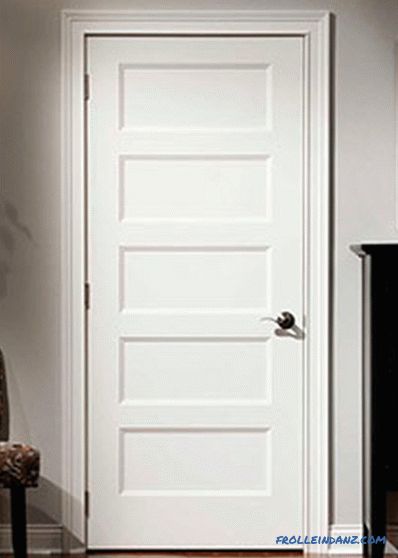
General purpose rooms
-
800 x 2000 x 20-70 mm.
In industrial construction houses, the dimensions of the door openings are standardized, but in private cottages and country houses, door sizes vary quite considerably. When building your own home it is best to adhere to generally accepted standards - there will be fewer problems, both when ordering and when installing doors.
When ordering doors, it is necessary to determine the main dimensions:
- door opening around the perimeter;
- box thickness;
- width cuts;
- threshold sizes (if any);
- sizes of dobor.
As a rule, most sellers of standard-made doors on their websites provide sections under the heading "Calculator". With their help, it is possible to independently calculate the dimensions of the door being purchased, based only on the dimensions of the existing opening and the wall thickness (partition).
When ordering a door directly from manufacturers, it is necessary to call the measurer. Only in this case it is possible to achieve optimal size ratios and, in many cases, reduce the cost of construction and installation.
Which doors have the best noise insulation
When choosing a interior door, sound insulation level is often neglected. In the first place, as a rule, design, material production and cost. Only during operation the level of protection against noise is fully manifested.
Sound insulation applies to both protection against external noise and protection against the penetration of sounds from the room. As a rule, high-quality doors provide the same level of protection in all directions. The proper level of sound insulation is achieved by using internal fillers with certain properties in panel and molded doors and exterior decoration of all other structures.
In addition to reducing the acoustic conductivity of the sheet itself, it is necessary to pay attention to the properties of gaskets and seals in the zone of junction of the sheet with the box.
Of all the existing designs, the most effective in terms of sound insulation are:
- doors with a fake quarter;
- glazed;
- without internal voids;
- with a total thickness of at least 40 mm.
The effectiveness of the mock quarter is determined by the large area of contact between the sheet and the box. With properly fitted edges, the sound does not have the slightest chance of getting inside.
In the presence of glass, sound is transmitted quite effectively due to the solidity of the material. Even if triplex is used, the sound insulation is insufficient - internal vibrations are transmitted with almost no amplitude changes. The sound insulation effect can occur only in the low or high frequency region. But audible noises are transmitted almost unchanged.
Not a bad solution in terms of soundproofing, low-cost doors of a shield construction act. Due to the internal honeycomb filler made of cardboard or MDF, sound vibrations are damped over the entire range and external noise is reduced in intensity by more than 50%. Especially noticeable effect when filling the internal cavities with polyurethane foam or polyethylene foam. But such doors must be ordered individually.
Choice of the door frame
When deciding which interior doors to choose for an apartment, we must not forget about the door frame. It not only performs the functions of a bearing force element, which holds the canvas and ensures tight door locking, but also serves as the basis for the external decoration of the doorway.
By their design, the boxes are divided into ordinary and telescopic. The first are rectangles of timber, firmly fixed in the wall with dowels or anchor bolts. Platbands and other decorative elements are attached to them with glue, screws or nails without caps.
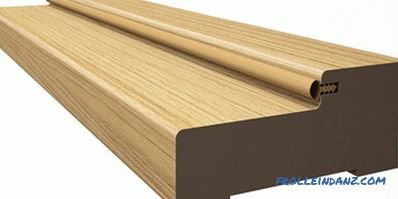
Profile of a conventional door frame.
Telescopic ones are equipped with special slots around the perimeter, into which the rims are fixed by means of special projections. They are more convenient to install than ordinary ones, and for facelift repairs without replacing doors and windows, they allow painting or sticking without extra time for dismantling the lining.
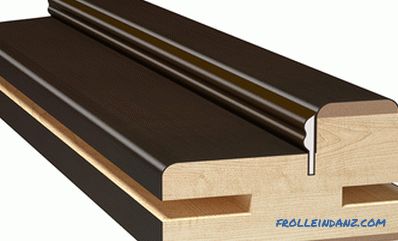
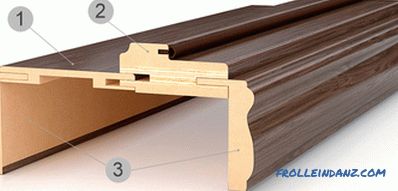
1 . Dobor
2 . Box.
3 . Casings.
Boxes also come with or without thresholds.The second option is very popular when finishing an apartment or house with floors on the same level. This is very convenient when using vacuum cleaners of robots and laying parquet on the entire floor area without transitions and joints.
With a threshold.
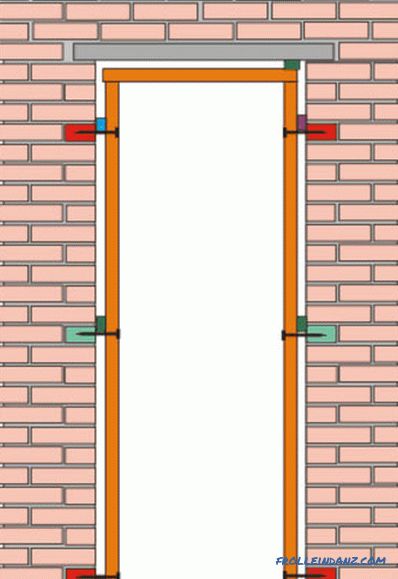
Without a threshold.
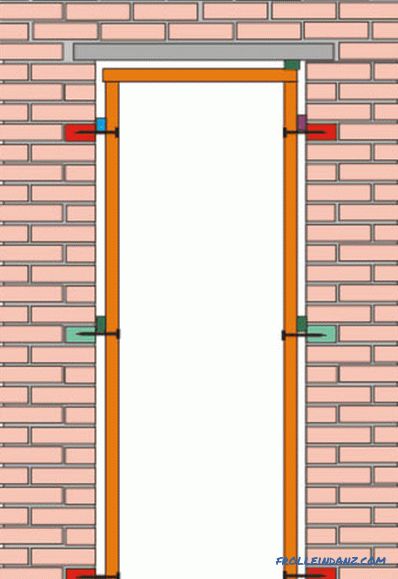
The choice of the box option influences the strength of the whole structure - usually vertical and horizontal bars are fastened directly to the wall using powerful dowels that penetrate deep into thickness of wall material. Boxes without thresholds can be made in the form of standard rectangles with upper and lower rails. If the threshold should not stand out above the floor, then the box dimensions are calculated so that it sinks under the floor.
One of the common mistakes when installing doors between rooms is that they are selected according to the residual principle after the main repair volume has been completed. A box must be installed before the installation of flooring. Only in this case, you can achieve complete harmony of all elements of the interior.
In most cases, the box is made of wood. But there are options made from pressed cardboard or MDF. Boxes made of such materials should be abandoned due to their weak strength and rigidity.
Finishing plates and trim plates
With a standard door frame width of 70 mm, it is very difficult to make it cover the entire thickness of the wall or partition. Most often the walls have a large width and the boxes must be expanded. This process is carried out using special inserts - dobor.
They are mounted by inserting between the angle of the opening and the cut of the box. As a rule, dobor are made in standard sizes 100, 150 and 200 mm wide. If their sizes do not coincide with the width of the opening + the width of the box, then the holes are sawn along the length to the desired width.
The following types of finishing are distinguished depending on the type of the end face:
- with an edge;
- without an edge;
- telescopic .
The edges are covered with PVC, laminate or ekoshpon, they are most common and very convenient to use.

Finishing without edge are covered with natural veneer, they are used on expensive versions of doors made of natural wood or base veneered with valuable wood.
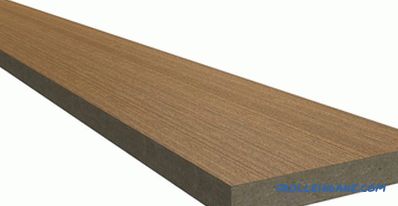
Telescopic extensions are equipped with a longitudinal protrusion or groove, ideally corresponding to the fixing elements of the box and casing. When mounting the door, they are assembled like a designer and form one monolithic compound, not even requiring glue or hardware. They are quite simple to install, if the thickness of the wall corresponds to the size of the door frame and dobor. Otherwise, the holes must be cut, which causes certain difficulties with the subsequent installation.
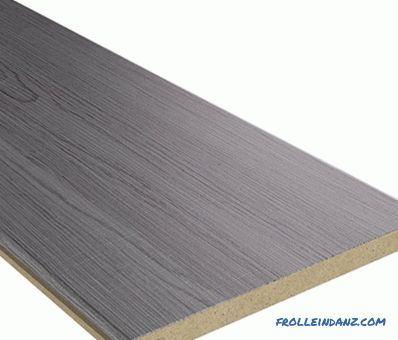
If there are very wide walls that are much larger than the standard dimensions of the panels, you can use two sets by joining them with a bead or with glue. When installing boxes with doborah, one rule should be followed: all elements are mounted before installation of the structure in the wall. So much easier to fit the size and firmly fasten the joining parts. Only after assembling the box to the required width can it be installed and fastened.
If the width of the dobor is not more than 50 mm, its separate installation is allowed. But it is necessary to accurately measure the width of the elements and choose a method of fastening that does not violate the integrity of the door structure. If you do not use glue or hardware, then over time, the box may crack and between it and the crack there will be cracks, which even with the help of putty is quite difficult to repair.
You can determine the required number of access points, depending on the wall thickness of the doorway and the width of the door opening itself, according to table :
| Thickness walls in mm | The width of the dobor | ||
|---|---|---|---|
| 1000 mm | 1500 mm | 2000 mm | |
| 70 to 90 | 1.5 | - | - |
| from 90 to 165 | 2.5 | - | 1.5 |
| from 165 to 215 | - | 2.5 | - |
| from 215 to 265 | - | - | 2.5 |
Platforms
One of the most decorative elements when installing interior doors is the trim. They not only mask the seam between the box and the wall, but also visually increase the doorway, which in many cases allows a certain way to influence the interior design.
You can choose platbands from several varieties that differ in a transverse profile. By this parameter, decorative strips are divided into:
Flat.
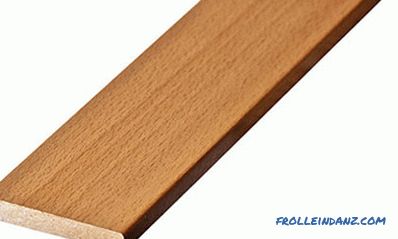
Semicircular.

Teardrop.
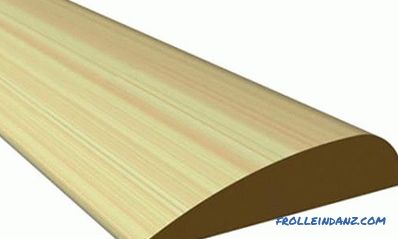
Figured.
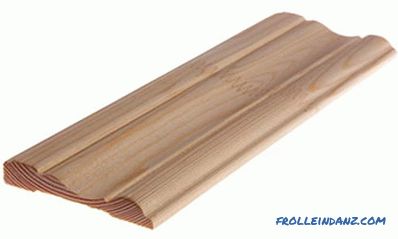
If the flat, drop-shaped and semicircular have a more or less standardized profile, the figured ones have a great variety and depend only on the type of cutter that was used for manufacturing.
As is the case with the box and the dobor, there are telescopic platbands. This type of platbands has a curved edge in the shape of the letter "G" over the entire length. The bent element, when mounting the casing, is inserted into the groove of the box or additional one. Thanks to this mount, it is possible to adjust the thickness of the box to the wall thickness.

The width of the platbands is from 7 cm, and the thickness is in the range of 8–10 mm. Flat and semicircular platbands are installed on most budget-level door designs. More complex - on the doors by special order or made of expensive wood.
The width of the trim depends on the size of the doorway. On small doors, practically no different from the standard, frames are mounted not more than 7 cm wide, for complex structures with an increased width or height strips up to 9 cm wide are used. More overall trim are used rarely - their role is to decorate the seam and underline the contour of the doors. The functions of self-decoration are not peculiar to them.
The installation of decorative strips on interior doors is a rather complicated operation, only seemingly elementary at first glance. When installing it is necessary to adhere to certain rules that determine the final appearance of the lining. The experience of builders says that finishing operations belong to one of the most difficult and responsible - all minor mistakes and miscalculations are required to level the finishing work.
The mounted ribs should form a perfect rectangle. To kill the contact edges at an angle of 45 0 a special template is used, called a cask. Without this device, making the right hand cut is almost impossible. And with this device, the cut is not ideal. For a high-quality cut, a special miter saw is used, which is installed at a given angle. Most often it is used in the installation of baseboards, but for the trim it is also quite suitable.
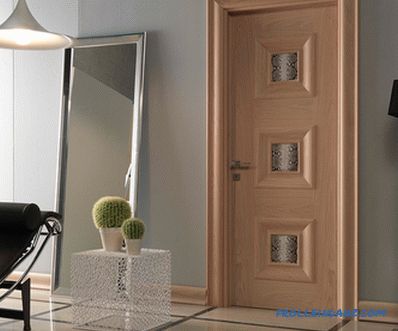
Sometimes the platbands are joined at an angle of 90 0 . Here, too, can not do without a special template and a saw with fine teeth (or jigsaw). It is easier to make a joint at right angles, but it looks less beautiful and professional than that made under 45 0 .
The frames are fixed with screws for putty, nails without caps or glue. The choice of method depends on the features of the box and the wall material. Although the platband in most cases is attached directly to the box, the features of the wall finish also have a certain value.

In addition to the usual platbands, more complex constructions are used for decorating doorways - capitals, cornices, canopies. They can be made from wood or from other materials - gypsum, polystyrene foam, polyurethane foam. Before you choose interior doors, it is necessary to fully develop the design of the design of the composition so that there are no problems, both when installing the door and when finishing the opening.
Gradation of prices for interior doors
You can choose interior doors by several parameters. The most interesting thing is that the price is not the main criterion. Sometimes a high-quality door of a standard hinged construction costs much less than a complicated folding or sliding one that will not last long. But it can be quite the opposite - the seemingly high-quality simple door will be less reliable than the construction of several canvases on hinges and rollers.
It is also difficult to determine which interior doors should be chosen for an apartment based on material only. There is an erroneous opinion that the doors made of oak or other expensive material are of higher quality than pine or of other coniferous material. Directly confronted with the properties of certain types of wood, most users radically change their views - with the relative cheapness of the pine is much more practical than oak or beech.
It does not crack, rarely shrivels, very easy to handle, which allows you to install hinges or locks without much difficulty. Pine is very susceptible to stains and paints, which cannot be said of oak or other hard woods, for example, bark. With a professional choice of varnish and stain, pine doors give 100% of the odds to any exotic tree, both in price and in ease of use.
Artificial materials, chipboard, MDF, composites, glass and metal are fully capable of replacing wood in the production of interior doors. According to their design qualities, ease of installation and durability, they are quite able to compete with wood.The price of even the most sophisticated exclusive models rarely exceeds the doors made of natural materials. And the strict requirements for the products of door manufacturers do not allow the market to be frankly of poor quality products hazardous to health.
What to look for
First of all, this is the manufacturer. Quality interior doors are produced in factories in Israel, Finland, and Belarus. Very high-quality Russian-made doors appeared, and they were able to compete not only in price, but also in quality.
The second parameter by which the door should be evaluated is the fittings. Loops, guides, handles, locks should be only metal. Any plastic indicates a low quality product. The power of the hinges and locks must correspond to the weight of the door and the material of manufacture, but even on light frame-and-shield doors, hinges or corners that can be bent by hand are unacceptable.
According to the price category, you can navigate to the following figures:
- from 35,000 rubles - elite doors made of solid wood;
- 10,000 - 20 000 rubles - quite decent doors made of wood, MDF, glass. They have a high level of decoration and a wide choice.
- 2 000 - 4000 rubles - the budget segment. An excellent choice for an average apartment or house. In terms of consumer qualities are not inferior to more expensive.
How to choose the color of interior doors
The choice of color is no less important a task than the choice of material or design type of doors. The door must comply with the overall design concept. The easiest way is to develop a single design project by professional artists, according to which repairs are made and the color solutions of all elements are determined in advance.
When choosing your own color, you should rely both on your own taste and on a few generally accepted rules. There are not many of them, so it is difficult to make a mistake. You can focus on contrast or harmony. The second option is more true - the style of the house should match the style and design of the door.

Doors made of solid wood or decorated with wood, suitable for almost all styles of interior, like white or painted in bright colors. The same choice will be successful if the floors in the rooms are of different materials, and the walls are painted in different colors.
You can choose the color of the doors to match the color of the walls, or in contrast with it. But there are a number of pitfalls - if you are going to repaint the walls, you will be limited in the color palette. With each repair to change the door is quite expensive.
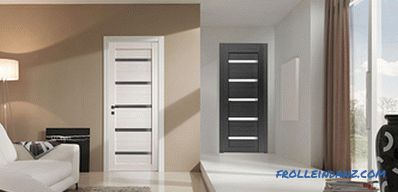
It is also difficult to choose the color of the door to the color of the furniture - it is not easy to buy furniture for all the rooms in the same color scheme. Therefore, it is best to focus on the color, which corresponds to the principle of harmony or contrast to most of the interior or color prevailing on the walls.
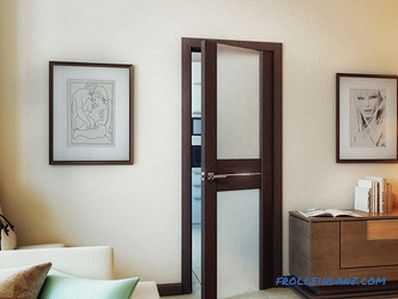
Sometimes you hear tips on how to choose interior doors by color, recommending two-color solutions — one surface, for example, light, and the other tinted under a tree. Such experiments are quite acceptable, but only if the interior concept was developed by a professional designer.
